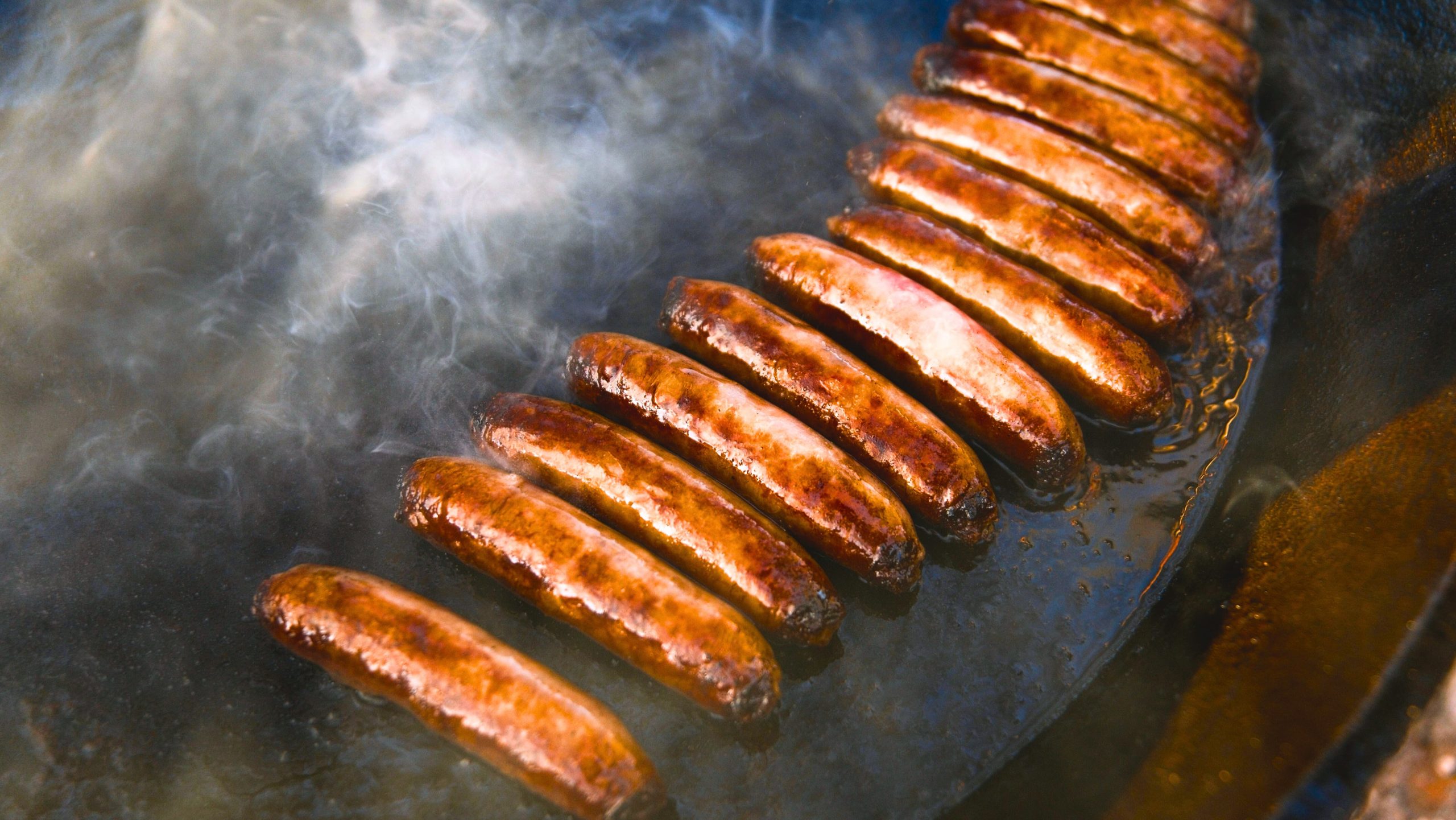Ever see those plump chicken sausages at the butcher shop with that perfect snap when you bite into them? There’s a reason they taste so good, and it’s not just the chicken. Most chicken sausages actually use pork intestines as casings fact that surprises many shoppers. In production runs and weekend farmers’ markets alike, lean chicken plus ~20% pork back fat in natural hog casings has been the most reliable way I’ve found to keep links plump and flavorful.While this mix works great for texture and moisture, it’s definitely something to think about if you’re keeping kosher or halal, or just trying to avoid pork altogether. Let’s break down why this odd couple works so well in the sausage world.
Key Takeaways
- Chicken sausage uses mostly chicken meat but often includes pork fat to boost juiciness and flavor.
- Use hog round and hog runner casings (properly cleaned intestines). Their natural collagen matrix breathes, so smoke and moisture move correctly key reasons pros still prefer them to most synthetics. and holds the sausage shape during cooking.
- Because the casing is from pig, these links are not halal or kosher. If you follow religious dietary laws, look for products certified by an accredited body and labeled ‘beef collagen’ or ‘sheep casing’ with no pork contact.
Composition and Ingredients of Chicken Sausage with Pork Casing
Main Ingredient: Chicken Meat
Chicken meat takes the lead here. It’s lean, mild, and gentle on the palate. Which also means it needs a little help to stay moist and full of flavor. That’s where pork fat comes in.My baseline is ~80% chicken / ~20% pork back fat for moisture and mouthfeel; drop much lower and you risk a mealy texture, go higher and you lose the chicken’s clean flavor. (1)It’s not just a random ratio. That fat content matters. Without it, chicken dries out fast once it hits the heat. Too fast.The pork fat melts slowly as it cooks, wrapping the meat in moisture and richness. It gives the sausage tenderness without drowning out the chicken’s light, almost delicate taste. And that balance is everything. Because in the end, you still want the chicken to shine.
Texture and Flavor Profile
The sausage feels firm when you bite into it, yet it gives just enough to feel satisfying. There’s a gentle chew, the kind that comes from a well-made pork casing.The chicken brings its own quiet flavor. Mild, clean, familiar. Then the pork fat and casing step in with a whisper of savory depth, rounding it all out. Nothing too loud. Just enough to make you notice.Seasonings play their part like a supporting cast. Garlic, basil, dried tomatoes, black pepper, sage. Each one adding its own small layer. Together, they lift the chicken’s light flavor without smothering it. And that’s the secret-letting the meat still speak for itself.
Pork Casing Characteristics
Origin and Material: Cleaned Pig Intestine

Credit: Edwards Virginia Smokehouse
Pork casing comes from cleaned pig intestines. A simple truth, though it carries a long history.
It’s a by-product of processing pork, yet it has been treasured for centuries by sausage makers who craft chicken sausage. People love it for its strength, for the way it stretches without tearing.
Collagen (beef) casings are consistent and easy to load, but they’re less elastic and can dry the bite: sheep casings are thinner with a delicate snap for breakfast links; hog casings stretch well, resist bursts, and give the classic ‘pop’ on grills.
There’s something about the way a natural casing feels that just works.
Before it’s used, it takes a soak in warm water. This softens it, makes it pliable, easy to fill. And then, it’s ready, quietly waiting to hold together all the flavor and texture that will come next.
Functional Benefits: Shape, Snap, and Cooking Performance
The main job of the casing is to hold the chicken sausage together. But it does even more! It gives the sausage a nice “snap” when you bite into it. Many sausage lovers really enjoy this texture.Here are some of the benefits of pork casing:
- Allows Smoke Flavor: The casing lets smoke flavor get into the meat. This makes it perfect for smoked sausages.
- Crisps Up When Cooked: Whether you grill, fry, or bake, the casing gets crispy. This adds a nice crunch to the juicy inside.
- Holds Shape Well: It keeps the sausage in shape while cooking. This makes it easier to handle and eat.
Pork casing is a great choice for anyone who loves sausages. It brings flavor, texture, and fun to every bite. Whether you are making your own sausages or buying them, knowing about pork casing helps you appreciate the craft.
Preparation and Cooking Techniques
Sausage Making Process
Making chicken sausage with pork casing is a fun and tasty project. Here’s how it works.
Grinding and Mixing of Chicken and Pork Fat
Start by grinding the chicken meat until it’s fine and even. Slip in some pork fat as you go. It’s the quiet counterbalance to chicken’s leanness, adding the richness that keeps every bite tender.Then came the seasonings. Add them with intention, following your recipe or your instinct. Mix everything thoroughly, letting the flavors wander and mingle until they’re inseparable.One thing you can’t forget is that the meat and fat need to stay cold. This isn’t just a casual tip. Keep everything near 32–35°F (0–2°C) meat, fat, grinder parts, and bowl. Cold grind + cold mix preserves myosin extraction, which is what makes a bouncy, well-bound sausage.Details decide texture: salt at 1.6–1.8% of meat+fat, mix until the paste gets tacky, and chill between steps.
Soaking and Stuffing Pork Casings
Now comes the casings. Let them soak in lukewarm water for about half an hour. The warmth loosens them, making them soft and flexible. After that, rinse them well, inside and out, until every trace of salt or grit is gone.Then the real fun begins. Stuffing. Slide the casing onto the nozzle of your sausage stuffer and start feeding in the meat mixture. Move slowly. Let the filling glide in gently, so the casing stretches but doesn’t strain. Too much pressure and pop. It could split later when cooking.Once they’re filled, twist or tie them into links. Twist into 5–6 inch links with light tension; don’t overstuff a finger’s give prevents burst skins on the grill.
Final Steps
Now, it’s time to cook. Grill them over steady heat, bake them in the oven, or let them sizzle in a pan. The choice is yours. Just remember, the size of your links will decide how long they take.No matter the method, make sure they’re cooked all the way through. No guessing. You want the center hot and safe, the outside browned just enough to tempt you.There’s something special about making sausages yourself. You taste more than the seasoning. You taste the effort, the little choices you made along the way. And the best part? You can make them exactly how you like. Spicy, mild, herby, smoky. Yours.You’ll taste it in the bite: elastic snap, intact juices, clean chicken flavor lifted by pork back fat the markers of a properly made link.
Cooking Methods

- Grill: Medium heat, lid down. Turn every 2–3 minutes; finish when the thickest link hits 165°F (74°C). Rest 3–5 minutes for juices to redistribute.
- Pan-sear: Start in a cold skillet, add a splash of water, cover and steam 6–8 minutes, then uncover and brown to finish. Temp to 165°F.
- Bake: 375°F (190°C) on a rack so air circulates; check at 15 minutes and temp to 165°F.
- Poach then sear: Hold at 160–170°F (71–77°C) water (no hard boil) until the cores reach 150–155°F, then finish in a hot pan to 165°F with a crisp skin. Don’t prick the casing, pricking dumps fat and dries the link.
In my shop we finish poultry sausages to 165°F (74°C) at the core pulled with a probe thermometer, not by guesswork. That’s the poultry-safe finish temp recommended by U.S. food-safety authorities and it keeps links juicy without overcooking. This temperature keeps you safe from any harmful bacteria.
Dietary and Cultural Considerations
Non-Halal and Non-Kosher Status
Many sausages use casings made from pork intestines. This means they are not halal or kosher. Even if the sausage is made with chicken, the pork casing makes it unsuitable for those who follow these dietary rules.
Implications for Consumers Avoiding Pork
If you’re avoiding pork:
- Read the casing line on the label to look for ‘beef collagen’ or ‘sheep casing.’
- Ask about equipment: some shops stuff pork and poultry on the same horn, cross-contact can matter for strict observance.
- Prefer brands with recognized halal/ kosher certification and clear casing disclosure.
The casing source is not always clear on the packaging. Here are some tips to stay safe:
- Check Labels: Always read the ingredients on the package.
- Ask Producers: If you’re unsure, don’t hesitate to ask the seller or producer about the casing.
Alternative Casings and Sausage Forms
If you’re avoiding pork, choose beef collagen for uniform size and simpler stuffing, or sheep casings for a tender skin on smaller links. (2)Expect slightly less smoke permeability and a softer snap than hog, which is normal, not a defect. Each option has its own pros and cons.
- Synthetic Collagen Casings: These are often made from beef or other materials. They feel similar to traditional casings but may not have the same snap when you bite into them.
- Sheep Casings: These casings are smaller and thinner. They give a different texture and are often used for smaller sausages.
- Skinless (uncased) links or patties: Bypass the casing issue entirely. Expect a softer exterior; to mimic snap, chill the formed links and pan-sear to develop a firm crust.
Each alternative has trade-offs in texture and how they cook. It’s good to try different types to find the one you like best.
Culinary Uses and Flavor Pairings
Chicken sausage with pork casing is a great ingredient to have in the kitchen. It can be used in many dishes and meals. Here are some common ways to enjoy it:
Common Dishes Featuring Chicken Sausage with Pork Casing
- Breakfast Platters: Pair it with eggs, potatoes, and toast for a hearty start to the day.
- Pasta Dishes: Slice the sausage and toss it in tomato or cream-based sauces for extra flavor.
- Grilled Meals: Serve it with peppers and onions on a hoagie roll or mix it with other grilled items.
- Casseroles and Stir-Fries: Add it to casseroles or stir-fries to boost protein and flavor without being too strong.
Spice and Herb Profiles
Chicken sausage has a mild flavor that pairs well with many herbs and spices. Here are some typical seasonings:
- Garlic: Adds a strong, tasty kick.
- Basil: Gives a sweet and aromatic touch.
- Sage: Offers a deep, earthy flavor.
- Black Pepper: Adds a little heat without being too spicy.
- Dried Tomatoes: Brings a hint of acidity and depth to the dish.
These ingredients work together to create a balanced taste that enhances the chicken and pork sausage. The combination makes each bite delicious and satisfying. Enjoy experimenting with chicken sausage in your meals!
How is a chicken sausage recipe different when you use pork casing sausage?
When following a chicken sausage recipe, using pork casing sausage changes the texture and bite. The natural pork casing gives more sausage snap and helps keep it a juicy chicken sausage. This is why pork casing benefits are often praised by home cooks. It’s also helpful to know sausage casing types before starting, since pork intestine casing works differently than collagen. The casing can affect chicken sausage flavor and how it feels when you bite into it.
What should I know before making homemade chicken sausage in natural pork casing?
If you’re making homemade chicken sausage, the choice of casing matters a lot. Natural pork casing holds moisture well, so you get a juicier chicken sausage texture. Learning pork casing preparation is important before stuffing chicken sausage. It’s also worth comparing pork casing vs collagen casing to see which matches your taste. Pay attention to chicken sausage seasoning, ingredients, and sausage making tips to get the best results. Even small changes in chicken sausage skin or stuffing can change the final bite.
How do different cooking methods affect chicken sausage in pork casing?
Cooking methods can change how chicken sausage in pork casing turns out. You can chicken sausage grill for a smoky taste, chicken sausage bake for even heat, chicken sausage fry for a crisp outside, or try chicken sausage boiling for a softer bite. Many cooks prefer grilling for extra sausage snap. Cooking chicken sausage links right helps keep them juicy. Whether you’re after chicken sausage breakfast, dinner, or snacks, the method you choose affects chicken sausage flavor and texture.
What’s the best way to store fresh chicken sausage in a pork casing?
Fresh chicken sausage needs the right chicken sausage storage to stay safe. Always check chicken sausage shelf life before eating. Store it in the fridge for short-term use or freeze it for longer. Whether it’s organic chicken sausage, low fat chicken sausage, or spicy chicken sausage, keeping it cold matters. Chicken sausage nutrition stays better if you avoid repeated thawing. Good storage helps keep chicken sausage protein high, chicken sausage carbs low, and the flavor as close as possible to when it was made.
Can I use pork casing sausage in different chicken sausage meal ideas?
Yes, pork casing sausage works well in many chicken sausage meal ideas. You can make chicken sausage pasta, pizza, or soup, or try chicken sausage gumbo, jambalaya, curry, or stew. For quick bites, make chicken sausage sandwiches, hot dogs, or wraps. They also work in chicken sausage breakfast burritos, omelettes, or quiche. For parties, try chicken sausage appetizers, skewers, rolls, or side dishes. Pork casing adds that extra sausage snap whether you cook chicken sausage stir fry, BBQ, in a smoker, or as street food.
Conclusion
Chicken sausage with pork casing is a product born from tradition and practicality. The lean chicken meat benefits from added pork fat for moisture, while the pork casing delivers the texture and cooking qualities that synthetic alternatives often miss. This combination results in a juicy, flavorful sausage with a satisfying bite. But it’s not without its caveats: those avoiding pork must look for alternatives or caseless options.If you’re curious about making your own chicken sausage or want to explore casing alternatives, start by experimenting with different fats and seasonings. Try soaking natural casings properly or test collagen casings to see which texture you prefer. And remember, cooking to the right temperature is key to enjoying safe, delicious sausage every time.Ready to try chicken sausage with pork casing? Look for trusted brands or local butchers who use quality ingredients, and don’t hesitate to ask about casing sources if dietary restrictions matter to you. Happy cooking!
References
- https://wurstcircle.com/recipes/chicken-sausage/
- https://www.mashed.com/1258463/sneaky-detail-should-look-when-buying-chicken-sausage/
Related Articles
- https://milkwoodrestaurant.com/chicken-sausage-meaning/
- https://milkwoodrestaurant.com/what-chicken-sausage-is-the-best/
- https://milkwoodrestaurant.com/chicken-sausage-vs-pork-sausage-nutrition/








